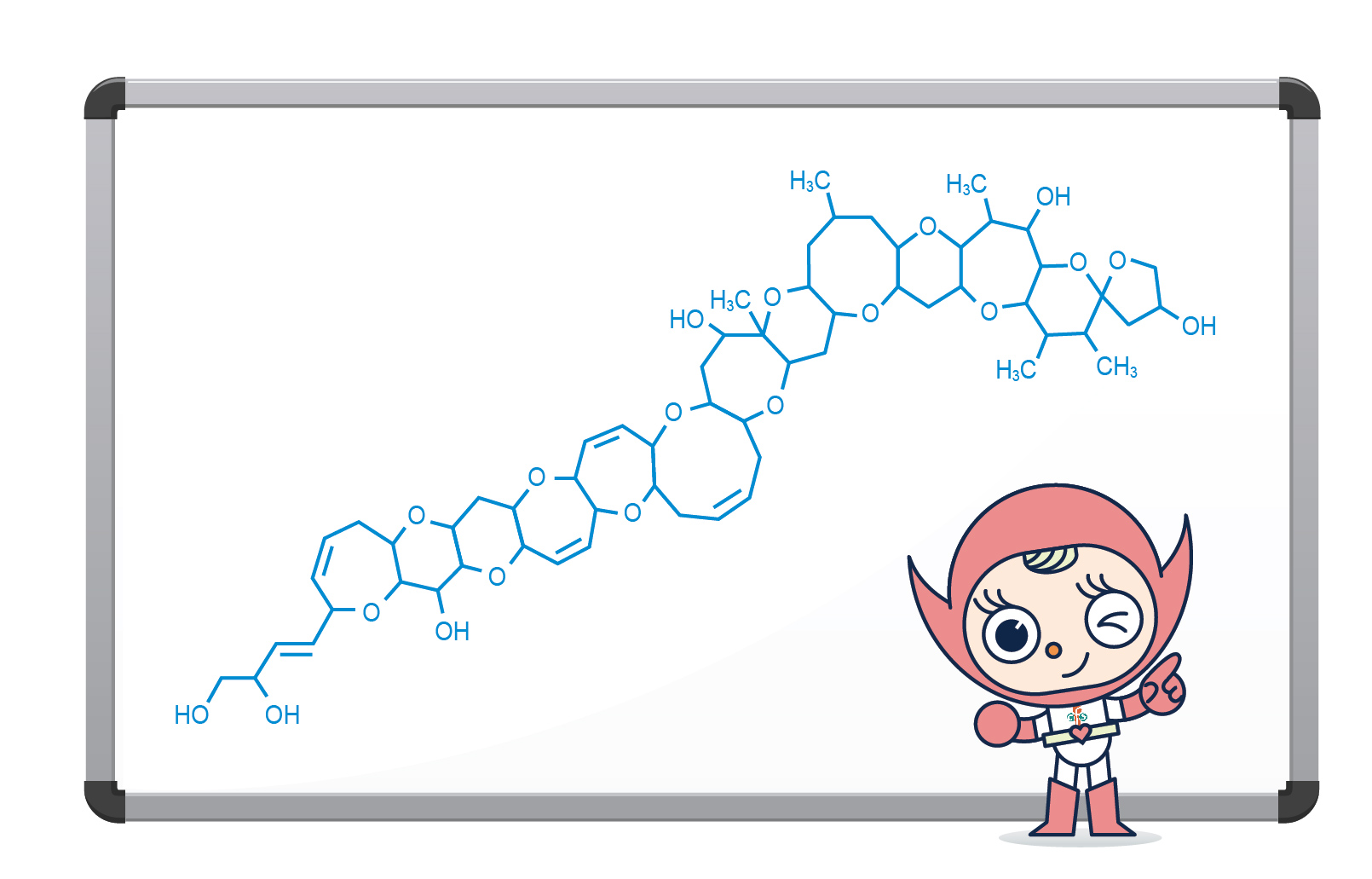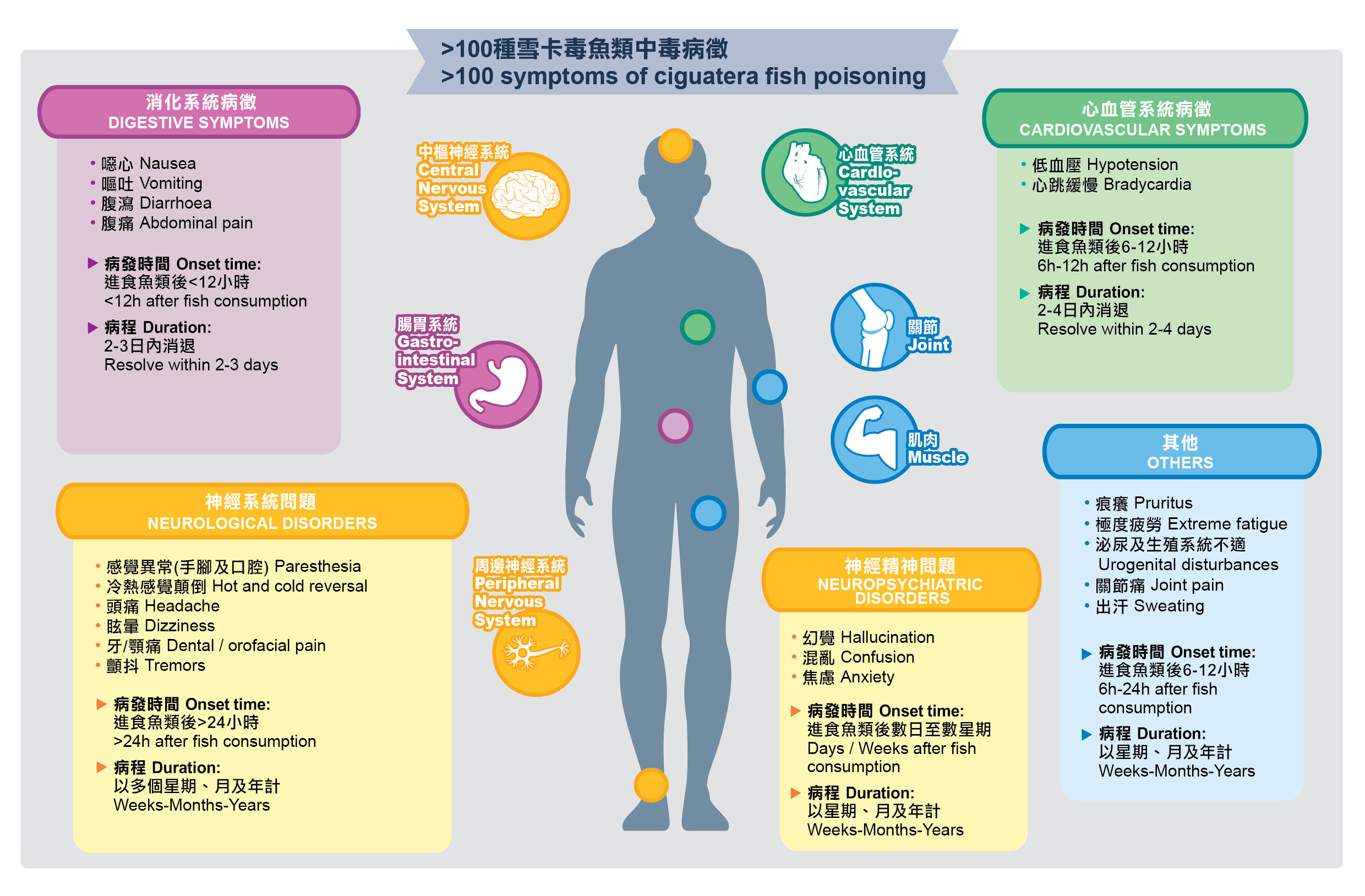
Food Safety Focus (194th Issue, September 2022)– Article 1
Ciguatera Fish Poisoning
Reported by Dr. John LUM, Scientific Officer,
Risk Assessment Section,
Centre for Food Safety
The Centre for Food Safety (CFS) received notification in August 2022 of a suspected ciguatoxin poisoning case who developed abdominal pain, diarrhoea, dizziness and limb numbness about five hours after consuming fish. The incriminated fish was a 10-catty Sabah Giant Grouper. So, what is ciguatera fish poisoning?
What is Ciguatera Fish Poisoning?
Ciguatera fish poisoning (CFP) is an illness caused by eating certain seafood, primarily coral reef fish, which contains the poisonous ciguatoxin. Ciguatoxins are a group of toxins that consist of more than 20 congeners, with a ladder-like chemical structure (Figure 1).

Figure 1. Chemical structure of ciguatoxin congener CTX1B (Adapted from Food and Drug Administration. Bad Bug Book, Foodborne Pathogenic Microorganisms and Natural Toxins. 2012)
Characteristics of Ciguatoxins
Ciguatoxins are lipid-soluble, heat stable, odourless, tasteless and not affected by cooking or freezing. They mainly accumulate in the head, liver, intestines and roe of fish. Ciguatoxin is not produced by fish, but rather originated from algae known as dinoflagellates (Gambierdiscus and Fukuyoa spp.) that are found in calm and protected waters around coral reefs. Coral reef fish become toxic from feeding on these toxic algae. In general, older and larger fish contain higher levels of ciguatoxins. However, the risk of CFP from eating farmed fish is very low.
Presentation of Ciguatera Fish Poisoning
CFP has been reported to cause more than 100 gastrointestinal, neurological, and cardiovascular symptoms, such as numbness and tingling around the mouth, nausea, vomiting, diarrhoea and dizziness. Acute symptoms appear from 30 minutes to 24 hours after eating the toxic fish. While most symptoms are similar to other food poisoning illnesses, hot and cold reversal – a burning sensation induced by contact with cold objects – is a classic CFP symptom.
There is no antidote or specific treatments for CFP. Previous CFP episodes, as well as the ingestion of alcoholic beverages, nuts and seed products, may exacerbate the severity of CFP symptoms.
In some patients, symptoms can persist for months or years. Symptoms may also recur from time to time up to years, triggered by eating certain foods (e.g. alcohol, nuts, dairy products and fish), changing behaviours (e.g. intense physical activity) or other factors (e.g. sun exposure).

Figure 2. Example of acute symptoms of ciguatera fish poisoning. (Adapted from FAO and WHO. Report of the Expert Meeting on Ciguatera Poisoning. 2020)
How Climate Change Affects CFP?
CFP is endemic between latitudes 35°N and 35°S, primarily around coral reefs in the South Pacific, Indian Ocean and Caribbean regions. CFP has become a global problem due to international seafood trade and has been reported in areas where the toxic algae is not found but stemming from imported fish.
Global warming could affect the growth and expansion of toxic algae because of the increased water temperature. On the other hand, other water areas may become too warm for the growth of toxic algae. Other global warming effects, such as sea-level rise and increases in precipitation, could also change the distribution and abundance of toxic algae.
Safety Level of Ciguatoxin
The Food and Agricultural Organization and the World Health Organization have evaluated the toxicity of ciguatoxins and could not establish a health-based guidance value (both acute and chronic) based on the available data. Some overseas food safety authorities have proposed a maximum concentration of 0.01 mcg CTX1B per kg fish flesh as being unlikely to cause CFP symptoms 1,2 .
Key Point to Note
- CFP is caused by eating coral reef fish which contains the poisonous ciguatoxin.
- Ciguatoxins are heat stable and would not be affected by cooking or freezing.
- Ciguatoxins mainly accumulate in the head, liver, intestines and roe of fish. Older and larger fish are more likely to contain higher levels of ciguatoxins.
Advice to Consumers
- Consume less coral reef fish, especially large ones, and avoid eating the head, skin, viscera (e.g. liver, intestine and ovary) and roe.
- Avoid alcoholic beverages, peanuts, nuts or beans when consuming coral reef fish.
- Seek medical treatment immediately when CFP symptoms appear.
Advice to Trade
- Avoid purchasing fish from unknown or suspicious sources. Avoid sourcing fish from areas knowingly at risk of having fish contaminated with ciguatoxins.
- Adhere strictly to the Food Safety Ordinance in record keeping, such that prompt and effective control measures could be taken for any CFP cases.
1 FAO/WHO Report of the Expert Meeting on Ciguatera Poisoning (2020)
2 WHO Food Safety Digest - Ciguatera Poisoning (2020)

